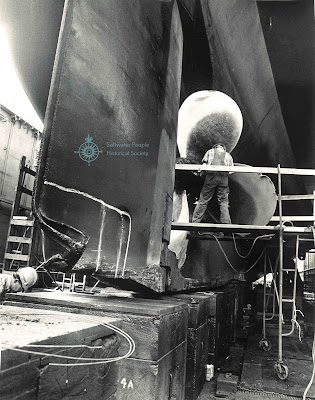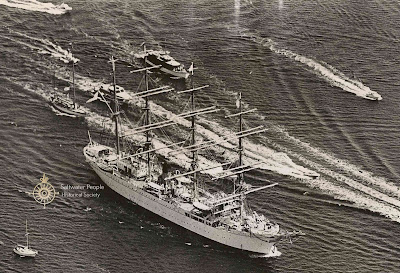Percival R. Jeffcott, Ferndale, WA historian, and Ray Jordan, Sedro Woolley member of the Skagit County Historical Society, are among the latest to inquire into the subsequent career of Lyman A. Cutler, who fired the shot that set off an international boundary dispute lasting 12-years.
The future park would pay tribute to the powers of arbitration, for no blood was shed, except that of the porker.
Lyman Cutler, after having raised a crisis that spread far beyond the bounds of the potato patch where he found a British hog rooting, did not remain long enough in the island to learn whether they were to be English or American. He was living on the mainland when the decision was reached.
Jeffcott, who believes he has tracked down Cutler's burial place south of Bellingham, recently told of his findings in a talk before the Ladies of Kiwanis group in that city. He said he has every reason to conclude that Cutler was interred on Deadman's Point, which later was hydraulicked into Bellingham Bay and that the pig warrior's last resting place is beneath industrial plants on what is now known as Commercial Point.
Cutler, a Kentuckian, aged 27, was among the first dozen American squatters on San Juan Island, arriving in April 1859, presumably after a disappointing experience in the Cariboo gold rush in B. C. He staked a 100-acre homestead claim on what is known as the Fraser place, facing American Camp Road near its intersection with the road to Mar Vista.
A contemporary described him as 'one of the unwashed sovereigns of the United States who did not scare worth a cent.' Another recalled he was 'tall, light-haired, fine looking, fearless, adventurous, and full of fun.' A third said he set up housekeeping with a native woman in a structure that was a cross between a tent and a hut.
Cutler is credited with having made a round trip of considerably more than 40-miles to Dungeness by sailboat to purchase a sack of seed potatoes for $30. He dug up about a third of an acre in the midst of a Hudson's Bay Co sheep run and sowed his spuds.
It is a marvel that a pig was the only one of the company's livestock to find them; several thousand sheep, 40 cattle, 35 horses, and 40 hogs, grazed at large on the south end of the island. The potato patch was fenced only on three sides; the terrain it occupied was part of Bellevue Farm, which the company had operated for six years.
On the morning of 15 June, Cutler saw the pig nuzzling among the potatoes, chased the animal into the nearby woods, and shot it. When the encounter was reported to Charles Griffin, manager of the farm. Cutler said he had been assured by American authorities that he had a right to the land, it was American soil, and he and other squatters would be protected by the US government.
A boundary commission, then at work, had not yet decided on which side of the international border San Juan lay. Until the point was settled, Griffin considered Cutler and his ilk trespassers. The manager at once sent a letter to his superior in Victoria. Before it reached its destination he received unexpected support. The steamship BEAVER came in from Nisqually with A. A. Dallas, the company's chief factor, on board.
The latter paid a call on the Kentuckian, told him that he had killed a breeding boar valued at $100 and intimated he had better pay for it or stand trial.
Cutler did not like the tone of the ultimatum. To him the animal was worth no more than a common razorback; he professed a willingness to settle for $10. Evidently hot words were said on both sides. Cutler later reported Dallas 'insulting and threatening' and Griffin was heard to remark that the Americans were a pack of intruders and he had been a fool ever to let the first one remain.
What happened after that is well known. Brig. Gen. William S. Harney, calling at the island on a tour of Puget Sound defenses, heard a highly colored account of the episode and dispatched Capt. George Pickett and 68 infantrymen from Fort Bellingham on 27 July to protect the Americans and prevent any attempt to carry Cutler off to Victoria for trial.
At the urging of fellow settlers, Cutler made himself scarce for some time. His friends were afraid he might get trigger happy and kill any British subject sent to arrest him.
Conflicting accounts exist as to what happened next. Paul K. Hubbs, Jr, American customs officer on the island, said that Pickett's first act on San Juan was to order Cutler's arrest and that Hubbs was deputized to go and get the culprit.
Pickett, one step ahead of the game, had appointed an American justice of the peace, Henry R. Crosbie. The latter, in a report to Washington, took credit for advising Cutler to place himself under Pickett's protection. The pig shooter acceded, to the relief of everyone.
Crosbie said that Cutler was in custody only one day. Hubbs insisted in an interview late in his life that Cutler never was tried by the authorities on either side. British reports present a different view. The captain of the SATELLITE said that Pickett told him on 31 July, Cutler was given a court hearing, fined heavily, and the amount would be paid to the Hudson's Bay agent to compensate for the loss of the boar.
That September, Hubbs helped Cutler phrase his story of the shooting in a favorable light, laying the firing of the shot to 'a moment of great irritation'. Cutler in the statement sworn to before Crosbie said he had expressed a desire to replace the pig at once.
Cutler at first gained prestige from the episode. He was elected constable by the Americans on the island and later served as a deputy sheriff, a post he was holding in May 1864. Then he disappeared from the San Juans.
The next one hears of him, he was 39 years old, unmarried, and living in Samish precinct in April 1871, with John Gray, a fellow Kentuckian, and logger. Jeffcott discovered that Cutler took a squatter's claim a short distance south of Blanchard, north of Bow in the northwest part of present Skagit County, 'east of the William Wood place.'
In 1874 Cutler became sick and moved to a hotel on Bellingham Bay to be near to a doctor. Jeffcott thinks it must have been in Sehome. On 27 April 1874, Cutler died, leaving an estate of $489.75 to which his father, brother, and sister in Michigan, were heirs.
Among his belongings, sold on 13 June at an administrator's sale, Jeffcott learned from county probate records, was the shotgun with which Cutler was said to have used to kill the pig. D. P. Thomas purchased it and many years later sent it to the Washington State Historical Society, where it now reposes. It was brought out last fall [1964] and displayed at a park hearing in Friday Harbor."
Above writing by Lucile McDonald, author/historian;
The Seattle Times, 30 May 1965.
 |
| Last page from The Pig War by Betty Baker Harper & Row, New York, and London, 1969. Library of the S. P. H. S. |




















.jpg)










